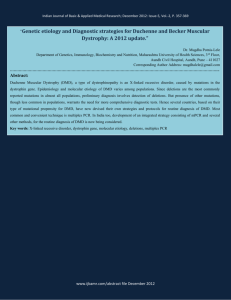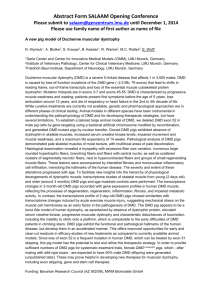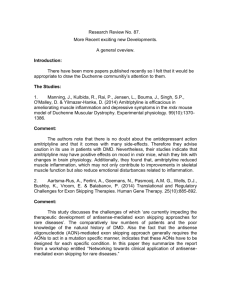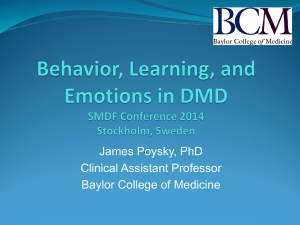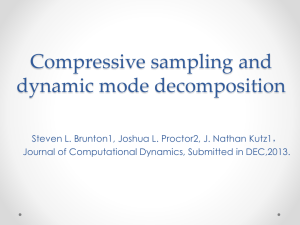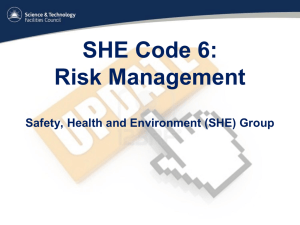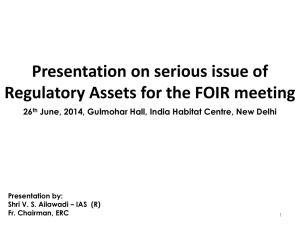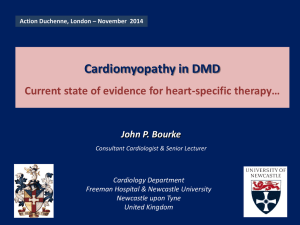Abdurakipov_Sergey
advertisement
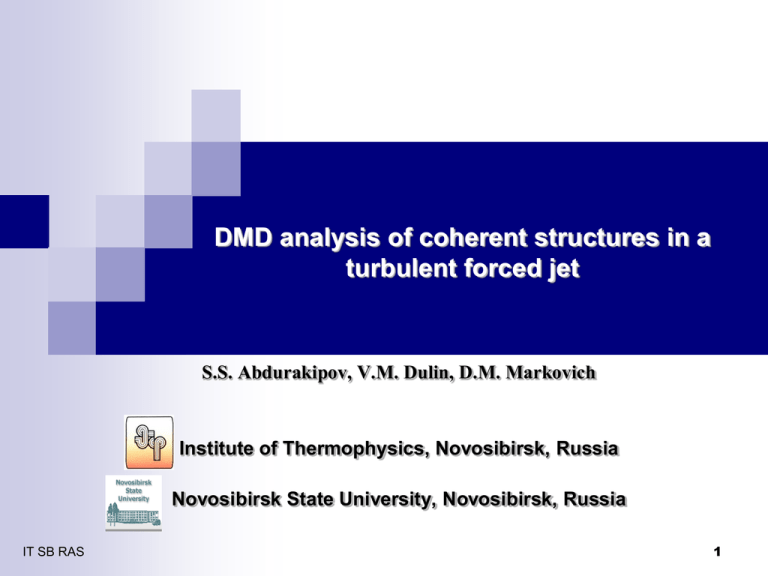
DMD analysis of coherent structures in a turbulent forced jet S.S. Abdurakipov, V.M. Dulin, D.M. Markovich Institute of Thermophysics, Novosibirsk, Russia Novosibirsk State University, Novosibirsk, Russia IT SB RAS 1 Outline Motivation and Objectives Experimental setup and apparatus Data post-processing Results Conclusions IT SB RAS 2 Motivation and Objectives Motivation It is well recognized (Crow & Champagne, 1971; Longmire & Eaton, 1992; Swanson & Richards, 1997) that dynamics of large-scale vortices are crucial for heat and mass transfer process in turbulent shear flows, such as jets. It is also well known that periodical forcing is an effective method to control formation of vortices these flows. However, as it was shown in Broze & Hussain, 1996, vortex formation in forced jets can be rather distinctive (depending on forcing frequency and amplitude), since dynamics of the nonlinear open system is strongly affected by a feedback from downstream events of vortex roll-ups and pairings. Particle Image Velocimery has now became a standard technique to measured spatial distributions of instantaneous velocity and is straight forward to investigate properties of coherent structures. A widely used technique for identifying coherent structures from velocity data is Proper Orthogonal Decomposition (POD) (Lumley 1967; Sirovich 1987; Holmes, Lumley & Berkooz 1996). The method determines the most energetic structures by diagonalizing the covariance matrix of snapshots. However, the important information about temporal evolution of coherent structures is ignored. Dynamic Mode Decomposition (DMD) method for identifying coherent structures was recently developed based on Koopman analysis of nonlinear dynamical system by Schmid (2010). In the DMD method the snapshots are assumed to be generated by a linear dynamical system, which implies that the extracted basis is characterized by growth rate and frequency content of the snapshots. Task IT SB RAS The aim of the present work is to investigate dynamics of coherent structures in a forced jet flow by applying Dynamic Mode Decomposition to high-repetition PIV data. 3 Experimental setup and apparatus Open aerodynamic rig: Air jet at Re = 4800, U0 = 5.0 m/s Contraction nozzle d = 15 mm. Free stream turbulence <3% Periodical forcing. St = 0.5, St = 1.0. LDV probe for the nozzle exit: urms = 10% of U0. High-repetition PIV measurements (1kHz): PCO 1200HS CMOS camera in double shutter mode. Image pair with 40s shift. 900 s between the pairs. Double-head Nd:YLF Pegasus PIV laser (2x10 mJ at 1.1 kHz) Synchronizing processor Processing (600 image pairs) Background removal from images Iterative cross-correlation algorithm with continuous window shifting (Scarano, 2002). IT SB RAS LDV probe Laser CMOS Camera Dumper Loudspakers Flow seeder Flowmeters Air 4 Data post-processing IT SB RAS 5 Dynamic Mode Decomposition (DMD) V1N u1 ,u2 ,u3 ,...,uN Ensembles of PIV velocity fields Decomposition of data ensemble into ,where u i corresponds to ti N 1 N 1 k 1 k 1 u( x, ti ) bk (ti )k ( x) e k r iik ti k ( x) Can be done by finding global Eigen modes of A ~ ui 1 e At ui Aui According to Schmid (2010) eigen values of A are approximated by following the modified Arnoldi method. u N a1u1 a2u2 aN 1u N 1 r V1N -1a r The least-squares problem for minimization or ||r||: V2N AV1N 1 Au1 ,Au 2 ,Au3 ,...,Au N-1 N N -1 V2 u 2 ,u3 ,...,u N u 2 ,u3 ,...,V1 a r Is solved by QR decomposition Eigenvalue problem of S: Sy k k y k , IT SB RAS V1N 1 QR S R1QT V2N or Y y1 ,...,y N 1 DMD basis for a small time-shift : 1 ,...,N 1 , AV1N 1 V1N 1S r eT V1N -1Y k 1 k a R1QT u N 0 0 e . . . 1 Ln(k ) kr iik 2t (Schmid , JFM, 2010) 6 Application to synthetic database Comparison of DMD versus Proper Orthogonal Decomposition method (Sirovich, 1987) N u ( x) k n 1 i aik and k aik u k ( x), i* ( x) 2 spat . ue y t -( )2 b e i 10 Hz 5 Hz 10 Hz 5 Hz max spat . cos(kx t ) cos(kx / 3 t / 2) b = 0.01, k = π/b, ω =2πf = 20π, σ = 0.4π, dt = T/Nt, T = 2π/ω, 40% noise mn Hz Synthetic data: y t -( )2 b DMD ank n ( x) n ( x),m ( x) Where POD Study of a forced turbulent jet IT SB RAS 8 Averaged flow structure 4 z d z d 2 2 2 1 1 1 1 1 r d 1 0.9 0.8 0.7 0.6 0.5 0.4 0.3 0.2 0.1 3 2 1 1 3 4 2 2 0.5 St 1.0, urms 0.1U 0 3 3 0 z d 4 3 3 0 4 St 0.52, u4rms 0.1U 0 Unfoced4flow r d 0 0 0.5 1 0 r d 0 0.5 1 0 r d 0 0.5 1 0 r d 0 0.5 1 0 r d 0 0.5 1 0.06 0.05 U U0 0.04 2 0.03 U 02 0.02 0.01 0 According to Broze and Hussain (1996), Forcing at St = 0.52 => Amplification of vortices at frequency of excitation Forcing at St = 1.0 => Stable pairing with modulation of second harmonic DMD spectra Unfoced flow St 0.52, urms 0.1U 0 St 1.0, urms 0.1U 0 For the unforced flow thee harmonics were detected: fundamental St = 0.4, pairing f0/2 and double pairing f0/4 Forcing at St = 0.52 => A strong peak at f0 was observed along with 2f0 Forcing at St = 1.0 => Several harmonics corresponding to modulation of pairing: fundamental f0, sub-harmonic f0/2 and f1 + f2 = f0/2 The instantaneous velocity and the most powerful DMD modes for St = 0.5 IT SB RAS 11 The instantaneous velocity and the most powerful DMD modes for St = 1.0 IT SB RAS 12 Low-order reconstruction from most powerful DMD modes for St = 0.5 u*r U 0 Low-order reconstruction of a sequence of seven velocity fields (time step 0.9 ms) IT SB RAS u e * k 1 i1k t 1 ( x) e k 2 i2k t 2 ( x) c.c. 13 Low-order reconstruction from most powerful DMD modes for St = 1.0 u*r U 0 Low-dimensional reconstruction of a sequence of 4k i4k t 3k i3k t * u e 4 ( x) e 3 ( x) c.c. seven velocity fields (time step 0.9 ms) Swirl strength criterion (Zhou and Adrian, 1999) for vortex detection IT SB RAS 14 Conclusions High-repetition PIV system was applied for estimation of a set of instantaneous velocity fields in a forced turbulent jet. Three regimes were considered: 1. Unforced flow with formation of ring-like vortices, their stable pairing and double pairing process; 2. Flow forced at St = 0.52, corresponding to the amplification of vortices at the frequency of excitation; 3. Flow forced at St = 1.0, resulting in a stable pairing of the forced vortices with modulation of their magnitude. The set of the velocity fields measured in the forced jet was processed by a DMD algorithm. The procedure provided information about dominant frequencies of velocity fluctuations in different flow regions and about scales of the corresponding coherent structures. It is concluded that superposition of relevant DMD modes (i.e., tangent approximation) satisfactory described nonlinear process of coherent structures interaction, viz., pairing of the vortices and modulation of their magnitude. IT SB RAS 15 Thank you for your attention! Acknowledgements: This work was fulfilled under foundation by Government of Russian Federation (Grant No. 11.G34.31.0035, Supervisor Ak. V.E. Zakharov) IT SB RAS 16
